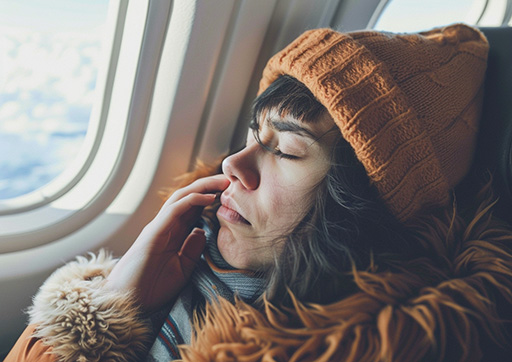Understanding and Preventing Motion Sickness

Recognizing these symptoms promptly allows you to take steps to alleviate discomfort. Here’s a list of common signs to watch for:
- Nausea and general unease
- Cold sweats and a pale appearance
- Vomiting or a feeling of wanting to vomit
- Dizziness and a sense of disorientation
- Headaches or a feeling of pressure in the head
- Drowsiness and fatigue
- Irritability and a short temper
If you notice these signs, consider them indicators that you should adjust your environment or activities to help mitigate the onset of further discomfort.
Common Causes and Triggers
When you embark on a journey, the last thing you want is to be sidelined by persistent nausea. Understanding the common causes and triggers of motion sickness is crucial for managing and potentially mitigating its effects. Here are some factors that may contribute to this discomfort during travel:
- Inner ear disturbances: The inner ear plays a crucial role in maintaining balance. Discrepancies between the motion your eyes see and the motion your inner ear senses can lead to feelings of nausea.
- Stress and anxiety: Emotional factors such as stress or anxiety can exacerbate the likelihood of experiencing motion sickness.
- Poor ventilation: Stale or stuffy air can worsen symptoms, so ensuring good airflow can be beneficial.
- Reading or focusing on a stationary object: Activities like reading or concentrating on a non-moving object while in motion can trigger discomfort.
You can proactively adjust your travel habits by identifying what triggers your discomfort. For instance, if reading in a moving vehicle causes issues, consider listening to audiobooks or music instead. If stress is a factor, explore relaxation techniques to help you stay calm during your travels. Remember, making minor lifestyle adjustments and being aware of your body’s responses can significantly impact your travel experience.
Preventative Measures Before Travel
Embarking on a journey requires thoughtful preparation, especially when maintaining your well-being. To ensure a smooth experience, consider these proactive steps:
- Medical Consultation: It’s wise to consult with a healthcare provider before traveling. They can offer personalized advice based on your health history and the nature of your trip.
- Know Your Destination: Research the healthcare facilities and emergency services available at your destination. Being informed can help you respond quickly if needed.
- Hydration and Nutrition: Prioritize staying hydrated and eating nutritious meals. This can bolster your immune system and help prevent stress-induced headaches.
- Stay Informed: Inquire about the latest Travel Health Notices from sources like the CDC, which can inform you about global health risks and how they may impact your travel plans.
Remember, by identifying potential issues early and taking the necessary precautions, you can significantly reduce the likelihood of discomfort during your travels.
Proactive Strategies for a Comfortable Flight
The seat you choose on an airplane can significantly influence your comfort during the flight. To minimize the effects of motion, consider positioning yourself in areas of the aircraft that are less susceptible to turbulence. Seats located over the wings or towards the front of the plane are typically more stable, as they are closer to the plane’s center of gravity and experience less movement.
- For the most stable ride, aim for a seat over the wings.
- A window seat can also be beneficial, as looking at the horizon may help align one’s sensory perceptions.
- Avoid sitting at the rear, where motion is more noticeable and may exacerbate discomfort.
By thoughtfully selecting your seat, you can enhance your overall travel experience and reduce the likelihood of discomfort. Remember, while seat selection can be a helpful strategy, it is just one of many considerations to ensure a more comfortable journey.
Dietary Considerations and Hydration
When preparing for a flight, paying attention to your diet and hydration levels can be pivotal in managing motion sickness. It’s essential to stay well-hydrated, as dehydration can exacerbate symptoms of discomfort. Aim to drink water regularly, avoiding diuretics like alcohol and caffeine that can lead to dehydration and increase the likelihood of feeling unwell.
Opt for lighter meals that are easy to digest. Heavy, greasy, or overly rich foods can worsen motion sickness, so choosing non-fatty food options is vital. It’s also wise to avoid large meals just before and during your flight. Instead, consider eating smaller, more frequent meals or snacks that are nutritious and not overly spicy or acidic.
These dietary considerations can help ensure a more comfortable flight experience. Remember, your choices about what to consume can significantly impact your overall well-being during air travel.

Natural Remedies and Over-the-Counter Solutions
When considering how to ease the discomfort of travel sickness, you may find a variety of natural remedies and over-the-counter (OTC) options available. Natural remedies, such as ginger or peppermint, are often favored for their minimal side effects and ease of use. Ginger, in particular, has been widely recognized for its ability to soothe the stomach.
- Ginger: Available in many forms, including capsules, teas, or raw, ginger can be a convenient choice.
- Peppermint: Sipping peppermint tea or inhaling peppermint oil can also be soothing.
Antihistamines such as dimenhydrinate (Dramamine) and meclizine (Bonine) are commonly used to alleviate symptoms of nausea and dizziness. Acupressure bands exert gentle pressure on the wrist at points believed to reduce nausea.
Before incorporating any remedies into your routine, it’s wise to consult with a healthcare provider. They can guide you on the appropriate options and dosages, ensuring that your choices suit your needs and circumstances well.
Managing Motion Sickness During Your Journey
When the unsettling feeling of motion sickness begins to creep in, turning your attention to your breathing can be a powerful tool. Start by taking slow, deep breaths, which can help soothe your body and mind, creating a sense of stability amidst the motion. This practice not only aids in managing symptoms but also promotes relaxation during your journey.
In addition to deep breathing, establishing a focal point can be beneficial. By fixing your gaze on a distant object, you align the information received by your eyes with that of your vestibular system, which is responsible for balance. This alignment can help diminish the sensory mismatch that often contributes to motion sickness. Remember, the goal is to reduce the conflict between what your eyes see and what your body feels.
Limiting Screen Time and Reading
When embarking on a journey, it’s essential to be mindful of activities that can exacerbate motion sickness. Engaging with screens or reading material can often lead to discomfort due to the conflicting signals sent to your brain. Instead, consider these alternatives:
- Look out the window at a fixed point on the horizon. This can help align your visual cues with the motion you’re feeling.
- Engage in conversation with fellow travelers or listen to audio content. This can distract your mind and reduce the focus on the sensations of motion.
Remember, the goal is to minimize the sensory mismatch contributing to motion sickness. Reducing screen time and reading gives your body a better chance to adapt to the movement around you. If you feel queasy, redirect your attention to a stable reference point, close your eyes, and rest for a moment. This simple shift in focus can significantly affect how you feel.
Rest Practices
During your travels, taking time to rest and engage in relaxation practices can significantly manage travel sickness. Listening to your body and allowing yourself moments of stillness is essential, especially during long journeys. Here are some strategies to consider:
- Prioritize sleep: Ensure you get a good night’s sleep before your trip and try to rest during travel if possible. Sleep can help reset your body’s equilibrium.
- Relaxation techniques: Engage in activities that promote calmness, such as listening to soothing music or practicing mindfulness meditation.
- Comfortable environment: Make your surroundings as comfortable as possible. Use a neck pillow, adjust the lighting, and maintain a proper temperature.
Remember, maintaining a relaxed state can help mitigate the sensations associated with travel sickness. Incorporating these practices into your routine can help create a more pleasant travel experience.
Special Considerations for Children and Pets
When planning a trip with young ones, it’s essential to consider how motion sickness might affect them. Children may not communicate their discomfort effectively, so managing potential symptoms is crucial. Here are some strategies to help ensure a smoother journey for your little travelers:
- Engage in pre-travel conditioning: Gradually introduce your children to short trips to help them acclimate to the sensation of travel.
- Create a comfortable environment: Ensure the vehicle is well-ventilated and that children have a clear view out the window. An excellent, airy space can help minimize discomfort.
- Distraction techniques: Keep children occupied with games or songs that encourage looking outside rather than down at books or screens.
Remember, children look to adults for cues to react in new situations. Maintaining a calm and positive demeanor can help lessen their anxiety and potential motion sickness. Encourage healthy habits in children by setting goals, creating routines, and making activities fun and engaging. Parents play a crucial role in influencing children’s behavior towards eating and physical activities.

Traveling with Pets: Recognizing and Alleviating Discomfort
When embarking on a journey with your pet, it’s essential to ensure their comfort to make the experience rewarding for both of you. The first step to a stress-free trip is recognizing early signs of discomfort in your furry friend. Here are some practical steps to help manage your pet’s well-being during travel:
- Ensure your pet has a comfortable space, such as a well-ventilated crate or travel harness that allows movement yet provides security.
- Fresh air is vital, so maintaining adequate ventilation in the vehicle helps prevent motion sickness.
- A familiar item with your scent, like clothing, can offer additional comfort to your pet.
- Avoid feeding your pet right before the trip to minimize the likelihood of motion sickness. A light meal a few hours prior is ideal.
- Consider the use of calming pheromone products or a special toy to provide a sense of tranquility and distraction.
If your pet is prone to severe motion sickness, it may be helpful to consult a professional to support it during travel. By taking these proactive steps, you can transform travel into a pleasant experience for your pet and ensure a smoother journey for everyone involved.
Emergency Preparedness for Unexpected Health Issues
Being prepared for unexpected health issues is crucial when embarking on a journey with your family. Start by scheduling a visit to your healthcare provider to ensure everyone is healthy and discuss any necessary precautions for your destination.
It’s also essential to research the healthcare facilities available at your destination, including hospitals, clinics, and pharmacies. Knowing local emergency numbers and medical services can be a lifesaver in an urgent situation.
Here are some steps to ensure you’re well-prepared:
- Medical Check-Up: Confirm that all family members are fit for travel and up-to-date with any required vaccinations.
- Packing Essentials: Create a travel medical kit with band-aids, antiseptic wipes, a thermometer, pain relievers, allergy medication, and prescription medications.
- Stay Hydrated and Nourished: Encourage regular fluid intake and nutritious meals to maintain energy levels and a robust immune system. Pack healthy snacks for long journeys.
Regular communication with your healthcare providers and ensuring a balanced diet and good sleep habits are crucial to managing chronic medical conditions while traveling. These proactive steps can help ensure a safer and more enjoyable journey for everyone involved.
Technological Advances

Applications for your smartphone or tablet can also play a significant role. Some apps are designed to help you anticipate and prepare for travel by providing tips and exercises that could ease motion sickness symptoms.
Others might offer guided meditation or breathing exercises to help you relax during your journey. Additionally, virtual reality (VR) systems are being explored to harmonize the visual and vestibular inputs, potentially reducing the sensory conflict contributing to motion sickness.
It’s important to remember that while these gadgets and apps can be helpful, they should be part of a broader strategy that includes other preventative measures and strategies discussed in this article. Always consult a healthcare provider before adopting any new approach to managing motion sickness during travel.
Research and Developments
Keeping abreast of the latest research and developments in travel wellness is essential for enhancing your journey experience. As new studies emerge and innovative solutions are introduced, they can help you adopt the most effective strategies to manage motion sickness.
- Regularly check reputable sources for updates on new findings and recommendations.
- Attend workshops or seminars that focus on the latest trends in travel health.
- Engage with online communities or forums where fellow travelers share their experiences and tips.
Integrating the latest insights into your travel routine can support your overall well-being and make your trips more enjoyable. Remember, knowledge is a powerful tool that can empower you to make informed decisions about your travel health strategies.
Frequently Asked Questions
What are the common symptoms of motion sickness?
Common symptoms include nausea, dizziness, sweating, and general discomfort. Some people may also experience vomiting and a pale complexion.
How can I prevent motion sickness before traveling?
Preventative measures include selecting a seat with the slightest movement, eating light meals, staying hydrated, and using motion sickness remedies such as medication or acupressure bands.
Are there any natural remedies for motion sickness?
Natural remedies like ginger, peppermint, and acupressure can help alleviate symptoms. Focusing your gaze on a stable point in the distance is also beneficial.
What are the best seating options to minimize motion sickness on a flight?
Choose a seat over the wings for the most minor turbulence or a window seat to maintain a view of the horizon. Sitting in a forward-facing position can also help.
How can I manage motion sickness during my journey?
Use breathing techniques to remain calm, limit screen time and reading to avoid exacerbating symptoms, and rest and relax as much as possible.
What should I do if my child or pet experiences motion sickness while traveling?
For children, ensure proper ventilation and distraction and consider over-the-counter medication. For pets, recognize early signs of discomfort and take preventative steps such as frequent breaks and a comfortable travel environment.
Conclusion
In conclusion, travel sickness need not be an inevitable part of your journey. By understanding its causes and symptoms and employing the strategies outlined in this guide, you can significantly reduce or even prevent the discomfort associated with motion sickness.
Whether it’s choosing the right seat, staying hydrated, focusing on your breathing, limiting screen time, or using motion sickness remedies, these measures can help ensure that your travel experiences are memorable for all the right reasons. Remember, a little preparation goes a long way toward smooth and comfortable travels. We wish you safe and pleasant journeys, free from the woes of motion sickness.
BioScan represents the pinnacle of innovation in Galvanic Skin Response (GSR) testing, offering practitioners a state-of-the-art tool for comprehensive health assessments. Whether you’re interested in the BioScanMSA for Meridian Stress Assessment or the BioScanSRT for Stress Reduction Technique, our devices are designed to integrate seamlessly into your practice.
